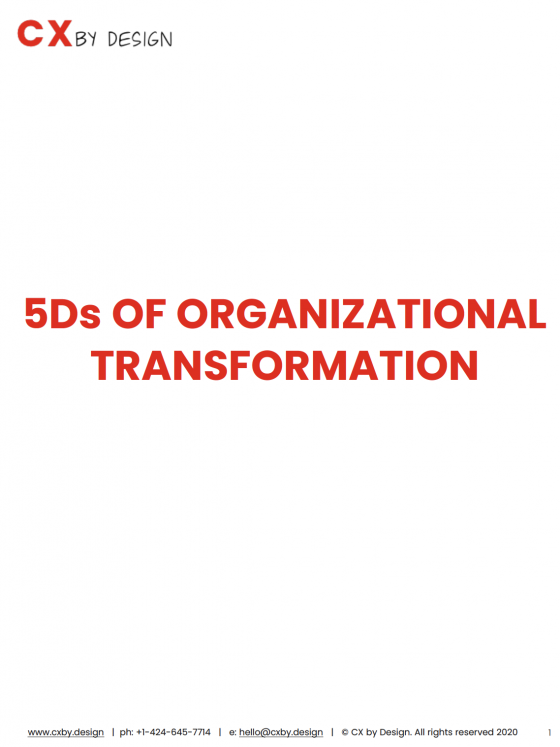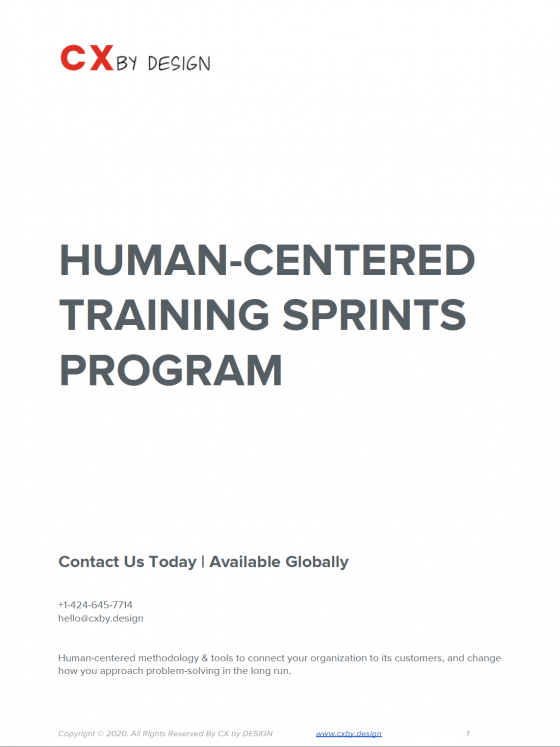Featured Resource

Human-Centered principles and the HCD framework are powerful assets for any business. Not only can businesses utilize these resources to ensure their products and services meet customer needs, but they can also use them to increase employee motivation and satisfaction; creating a sustainable and meaningful business.
The benefit of using HCD over other methods is simple. By putting the people central to the problem at the center of the solution finding process, the time and resource waste caused by uninformed, politicized guesswork decreases dramatically. Instead of jumping on what seems like a good idea, only to realize it misses the mark, you take a targeted approach in which you learn, adapt, and gain clarity as you solve.
But you know all of this.
You also know that there is no one way to put this framework to use. You could hire a team or implement design sprints or self educate and iterate your way to human-centeredness.
The real challenge lies in figuring out the best way to put HCD to use in your organization; knowing which methods to employ, and when, to achieve a sustainable, consistent outcome.
In fact, you may be asking yourself:
What can I do right now to be more human-centered, and what is the best way to begin?
Just Start
Be like Nike and Just Do It.
If HCD can be used to address almost any question, surely this one is no different. Why not start with putting HCD to use in answering it?
Note: Just in case you missed it above and you want more information about what exactly we mean by the HCD process; click here before continuing.
How to Use HCD Now
Using HCD doesn’t always require formalized research and large teams. It’s a method you can start applying at any time. Here’s how:
Discover
Start by investigating your current state. To do that:
- Answer the question: Who are the people affected by making our organization more human-centered?
- Then, go out and gather data from them and the affected systems so you gain a clear picture of your starting point.
Depending on several factors (i.e. the size of your team, company, etc) this data gathering process may mean you sit at your desk for an hour or so thinking through and notating all you know. Or, you may have to go to other departments, employees, or even customers to gather input. (Pro Tip on talking to others. Make sure you practice Active Listening).
During this step, you’re asking questions like:
- What parts of the business could benefit from a new approach?
- From a customer or employee perspective, what is good/missing in our organization/department today?
- Who would be impacted by us adopting a human-centered approach HCD? How would they be impacted?
- Do I need a team for this? Are there people available?
- How much money/time/space is available?
As you gather information be sure to record it all. Consider using Google Drive or some other cloud-based note-taking tool so that you can share this data if needed.
Define
After you’ve asked and answered (or not) these questions you have data. You’re aware of the potential gaps in your business that being more human-centered can fill. You probably have an idea of the resources available for HCD, and may even have inklings of top priority items to address.
Now, take a minute to group your findings. Again this doesn’t have to be a huge undertaking. Simply group similar information together to see if any additional gaps, patterns, opportunities, or priorities for utilizing HCD surface (i.e. “oh we should really start with looking at beefing up the marketing teams customer knowledge…”).
One of the ways we do this is using a visual tool like Trello. This type of tool allows us to create columns of similar information. These columns contain cards that house individual pieces of data. (For Example: If a column is named “Marketing Initiatives” a card may include an example marketing initiative like “Digital Marketing Masterclass”.)
Trello also has some great business templates to choose from to help you get a bird’s eye view of your data. For example this Company Overview Template has a setup with teams, ideas, and more.
Design
Once you’ve grouped what you know about your current state, it’s time to develop ideas and design a plan for change. This is the time where you marry your data with potential ways of working with HCD in order to manipulate and iterate towards progress.
For example, looking at the information you gathered and grouped, you might realize you won’t have an internal team that can carry out any Human-Centered initiatives until at least 6 months from now. However, you also realize that, before that time, your marketing team needs to differentiate its initiatives in order to meet goals.
Depending on the time and budget you have available, you could hire an external human-centered team to ramp up momentum in the marketing department.
You may instead find that a Human-Centered focused design sprint could give your highly capable marketing team the right amount of new ideas and perspective it needs to think differently (while leaving them empowered and ready to iterate).
Finally you may decide to go the do-it-yourself route in reading and educating your marketing team on the principles of HCD.
Since you have the constraints, gaps, and priorities in front of you, designing timelines and solutions that are not only within those constraints, but also fill your gaps and align with your priorities, is much easier. Plus, going this route also produces a more comprehensive and effective plan.

Deliver
Now that you know the resources you have available and the type of HCD help you need, it’s time to put change into action. In many organizations this means getting final sign off and buy-in from management before searching for teams/resources that meet your needs.It may also mean putting feelers out internally for resources that can be your HCD allies.
Either way your plan is ready to be put into action (while being subject to change as you learn). Before long you’ll have the right team or resources in place, and you can hit the Play button to become more Human-Centered. Well done!
But…
Data
Perhaps the most overlooked part of the HCD process is measurement and iteration.
Let’s face it. You simply won’t know every single piece of information or possibility up front, nor will you know these at any point in time. There will always be unknowns; we must accept that.
Once you do accept this fact, you’re able to work with its reality. You do that by gathering feedback, data, perspective, then going back to your plan and adjusting.
For our business this resembles creating and adhering to high-level goals, creating a short term plan off what we know (with a long-term end point in mind), and constantly updating our plan as we learn. This style ensures we don’t spend too much time coming up with the perfect plan (which we know will change) while also ensuring we are moving ahead and making progress.
The point is whichever way you decide to plan, be prepared for your plan to change. And know, that’s OK!
As long as you collect feedback and use it to make informed changes, it doesn’t negate all the hard work you’ve done. Rather, it better informs your plan and helps you do less guess work. A win-win!
How does applying the HCD way of planning really help?
The most important aspect of working with the HCD process is that it’s both informed and it better informs.
It empowers you to add rigor to your planning and use your resources wisely.
The principles of HCD are comprehensive which means you and your team will churn less, putting resource and timing waste aside.
By focusing on:
- Who and what is most affected by your problem or question,
- Then defining what the context of your problem or question is,
- And, finally, taking time to ideate and plan for addressing these foci
… you set yourself up for meeting your goals without the endless guessing that rework and redos feed off of.
After you’ve journeyed through the 5D’s of HCD in this way, you have a holistic, systematic answer to the question: What can I do right now to be more human-centered, and what is the best way to begin?
You’re also now empowered with the information needed to go about finding an answer that meets your customers’ and/or employees’ needs, your organization’s needs, and one that fits within your resource constraints.
Lastly, you know your plan will change, and have set yourself up to handle that change with focus and ease.
By spending time and money before integrating this rigor, you run a high risk of focusing on the wrong problems, with the wrong people, at the wrong time. You create a culture of decline instead of a culture of progress.
Instead of running the risk, just start with HCD. After-all, there really is no wrong way to put the framework to use. The only error would be in choosing not to.
